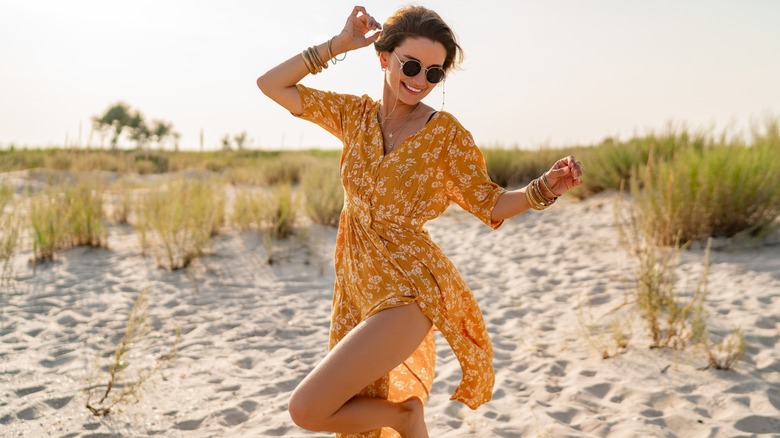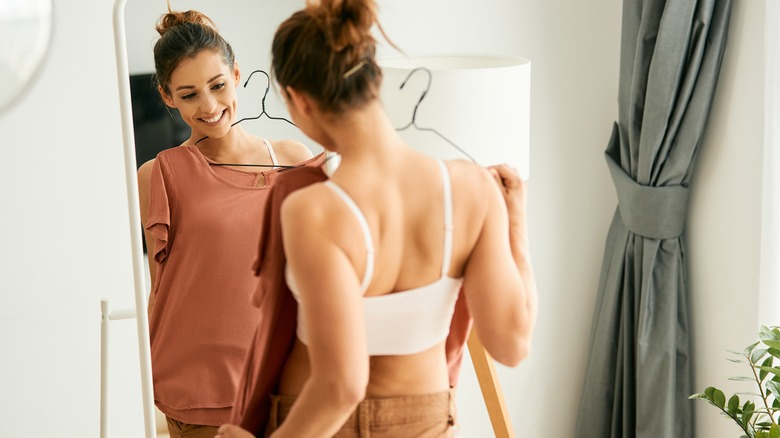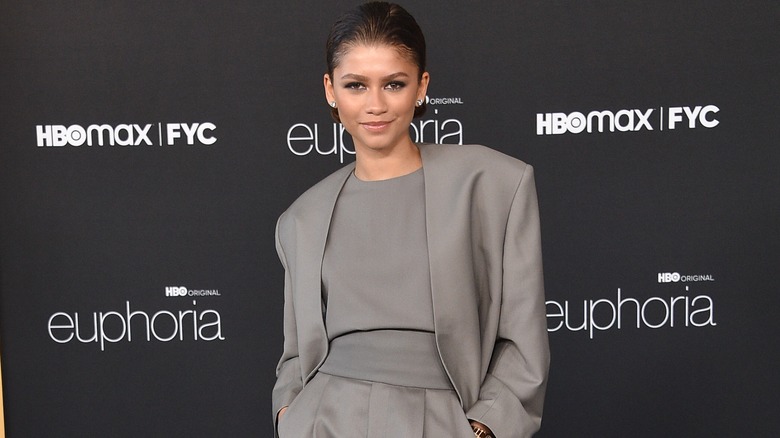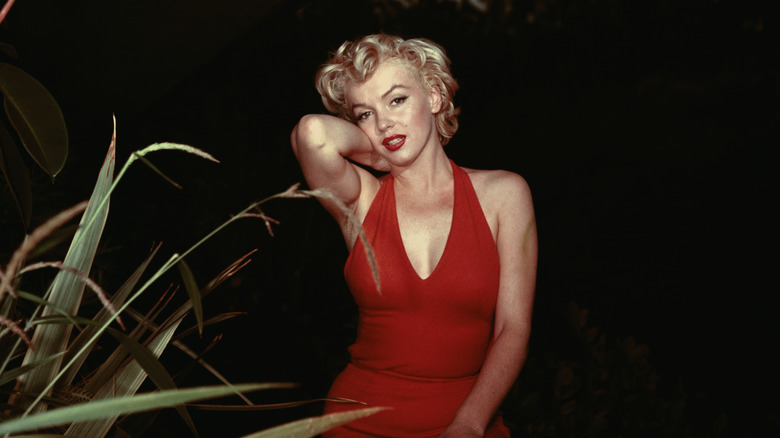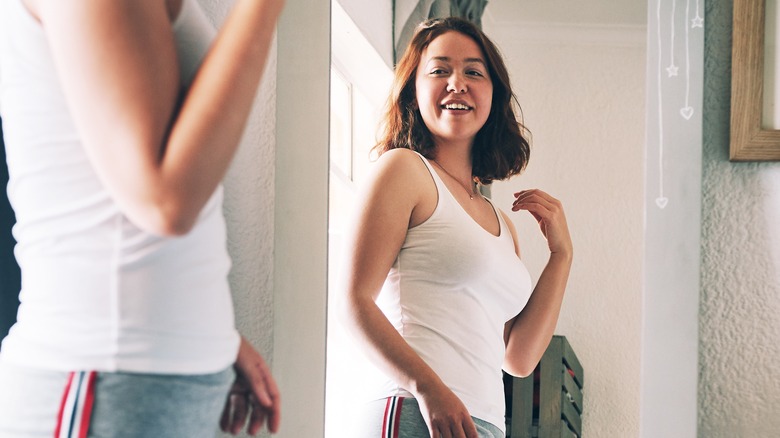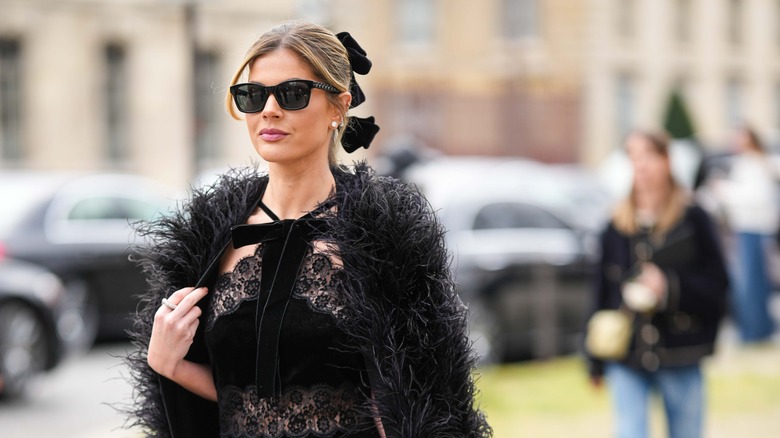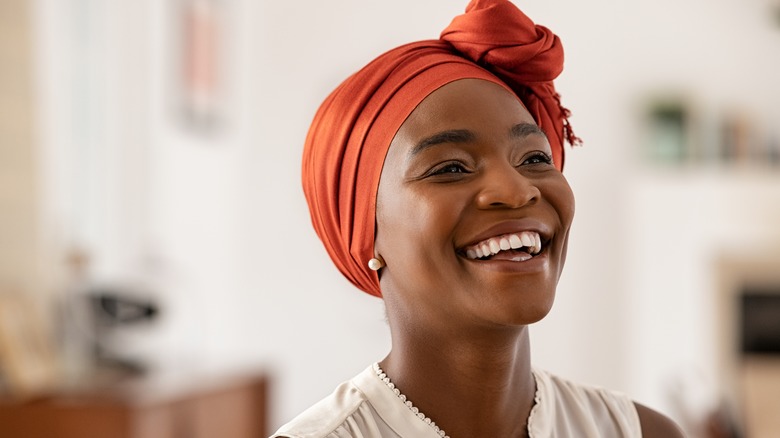TikTok's Kibbe Body Type Trend Can Help You Find Your Ideal Silhouette
Like a portal into your mom's old fashion magazines, TikTok loves a beauty trend revival. One of the more complicated yet intriguing retro trends on TikTok is the Kibbe Body Type System.
The Kibbe System is a styling method developed in the late 1980s that defined 13 body types and how each type should dress. Today, the Kibbe System only uses 10 body types, but most of the core ideas remain the same. Unlike more restrictive and judgmental systems that categorize body shapes into opaque terms like hourglass, pear, apple, and — the most cringe-inducing of all — spoon, the Kibbe body types are inclusive and speak to the unique features of different body shapes.
The Kibbe system works well for body positivity and body neutrality, and it also has the fun of personality quiz results: you get a highly specific description of your body type and a flattering list of celebrities who share similar features. At first glance, the system seems jargon-heavy, but with a few simple explanations, Kibbe body types can introduce you to a highly effective way of approaching your style.
What is the Kibbe system?
The Kibbe system was introduced in 1987 by stylist David Kibbe, who published a book entitled "Metamorphosis: Discovering Your Image Identity and Dazzle Only as You Can." The book outlines 13 body types and offers guidance on styling each type. Kibbe's book also attributes certain personality traits to the body types, which, while entertaining, probably isn't as useful as the clothing tips.
Kibbe body types center around "yin and yang" features. The term is problematic, but the concept makes sense: "yin" is soft curvy features, and "yang" is sharp angular features. The body types make up the spectrum of the softest body structure to the most angular, and are as follows: romantic, theatrical romantic, soft gamine, gamine, flamboyant gamine, soft classic, classic, dramatic classic, soft natural, natural, flamboyant natural, soft dramatic, and dramatic. In the last few years, David Kibbe has stayed away from using natural, classic, or gamine to classify people, as these "pure" types don't reflect the nuance of real body features.
Kibbe's method of thinking of bodies as soft or angular is quite size-inclusive: your weight doesn't determine your body type, it's about your bone structure and where your body has curves. The Kibbe system also describes bodies as having width and vertical elements. Although Kibbe's original book has some specific height ranges, most of the discussion around width and verticality relates to the relative proportions of your body, such as whether you have long limbs (vertical) or broad shoulders (width).
The yang Kibbe body types
The Kibbe system is thorough enough to have a 252-page book written about it, so you'll need to spend some time researching to have a deep understanding. You can start with the five main Kibbe types: dramatic, natural, classic, gamine, and romantic. Dramatic and natural encompass the types with more "yang," or angular features, with classic marking the transition into the softer traits.
Dramatic is the most angular body type. A dramatic body type is either tall or appears tall, and has a long, narrow frame and a sharp bone structure. According to the system, people can be either pure dramatic or soft dramatic, which shares the angular features of a dramatic but has a slightly wider bone structure and fuller curves.
The natural body type is still angular but is closer to being soft than the dramatic type. A natural type's bone structure is best described as blunt instead of angular, with broad shoulders and other wide, slightly rounded features. The two categories for this type are flamboyant natural — broad but more angular — or soft natural — broad but more fleshy and curvy.
Classic is a blended balance of soft and sharp features, with moderate height and proportions. As the name suggests, this is the "classic beauty" with symmetrical features. If you don't observe significant sharpness or softness in your body, you could be either a dramatic classic (a balance leaning towards angular features) or a soft classic (a balance leaning towards softer, fleshier features).
The yin Kibbe body types
After soft classics, the Kibbe body types become more curvy and fleshy, or as Kibbe would say, "yin." These types are sorted into either the gamine or romantic categories.
Gamine types are also a mix of soft and angular features, but rather than a blended balance like classic types, the gamine body types are all about contrast. The gamine type has a short, delicate frame, but fairly sharp or broad features (think Audrey Hepburn or Liza Minnelli). Kibbe categorizes people as either flamboyant gamines, which are petite body types with muscular flesh and relatively straight figures, or soft gamines, which have larger curves and softer flesh.
The final type is romantic, the softest, curviest body type. The romantic type is fairly short with lush, dominant curves in the breasts and hips. Your bone structure might be wide but it's still petite, and most of your hip and shoulder width comes from flesh, not bone. The go-to example is Marilyn Monroe. Per the Kibbe system, you can be either a pure romantic or a theatrical romantic, which is still extremely curvy and soft but has slightly angular bones.
All of the types have some overlap, and no one fits neatly into them. The original Kibbe book also isn't inclusive in its examples, focusing primarily on white, thin, able-bodied female celebrities. You can find a wider range of Kibbe type examples online, as well as some valuable discussions on using the system inclusively and productively.
How to find your Kibbe body type
Finding your Kibbe body type takes a good bit of analysis. Per The New York Times, David Kibbe isn't even that comfortable with people trying to type themselves, as the system is best used as an analysis tool for style consultations. However, since most of us aren't making appointments with fashion consultants any time soon, Kibbe's ideas are still worth exploring on your own.
To analyze your body type, look at photos of yourself where it's easy to observe your natural body shape. You can also take a new photo to analyze your body type, or simply look at yourself in a full-length mirror. Consider your basic features that are relevant to the Kibbe system: vertical, width, softness, and angularity. Do you look tall or short in photos? Are your shoulder and hip bones broad or narrow? Are the edges of your bones sharp or blunt? Does the flesh on your body feel more thick and more muscular, or soft and squishy?
After considering your features, you can start comparing them to the descriptions of the Kibbe body types. It may help to look at celebrities that David Kibbe has officially typed, to see if you share similarities with any of them. There are also several helpful resources online, such as the Kibbe Body Type Test based on the quiz from the Kibbe book, the r/Kibbe subreddit, #kibbebodytypes on TikTok, or the Strictly Kibbe Facebook group (sometimes visited by David Kibbe himself!).
How to use the Kibbe system to enhance your style
In the Kibbe system, no body type is more desirable than others. The purpose of Kibbe types is to make style choices that accentuate your features, not conceal "bad" parts of your body.
Kibbe's book provides detailed style guidelines for each body type. Most of the tips focus on your clothing line, the silhouette that clothes make when hanging on your body. For instance, Kibbe recommends that soft naturals wear flowing clothes with gentle waist emphasis. Overall, Kibbe's advice tends to align your body structure with your clothing line: people with angular bodies should play up their dramatic features, while people with curves should celebrate their gorgeous natural shape.
The Kibbe trend on TikTok has a more flexible attitude, and the Kibbe fan community loves to swap ideas. Any style can suit any body type, and TikTokers use the Kibbe system as a guide to developing the best version of the style for your features. For example, TikTok creator Jada Zhané uses "The Fresh Prince of Bel-Air" character Hilary Banks to show how classic types can pull off an edgier look. r/Kibbe is also full of innovative style concepts for each body type.
Another clever way to utilize the Kibbe system is through celebrity examples. David Kibbe has publicly confirmed the body types of dozens of celebrities. By looking at the style choices of celebrities who share your Kibbe type, you can get tons of inspiration for your own wardrobe.
The pros and cons of body typing
Body typing is a messy business. Overanalyzing your body can leave you too fixated on your appearance, and is an especially bad idea if you struggle with body dysmorphia or disordered eating. However, when you treat body typing as a fun exercise for refreshing your style, it can be a positive practice.
With that in mind, the Kibbe system is definitely one of the more inclusive body type systems. For Kibbe, every body type is beautiful, and there is no mention of "problem areas." How much you weigh is a non-issue for the Kibbe system, and every type can be applied to both large and small bodies. Kibbe's typology can also offer a new perspective on choosing clothes, thinking of your outfit as a line of fabric that hangs on your body, rather than individual pieces of clothing.
Ultimately, the Kibbe system is just one way to try to articulate the inarticulable beauty of the human body, and, as with any body type system, is only relevant for as long as it serves your needs. The Kibbe community is a wonderful resource for fashion inspiration — except for the chronically online who take things a wee bit too seriously — but your body and your style preferences have the final say, and any guidelines from the Kibbe system should be treated as advice, not a rule.
